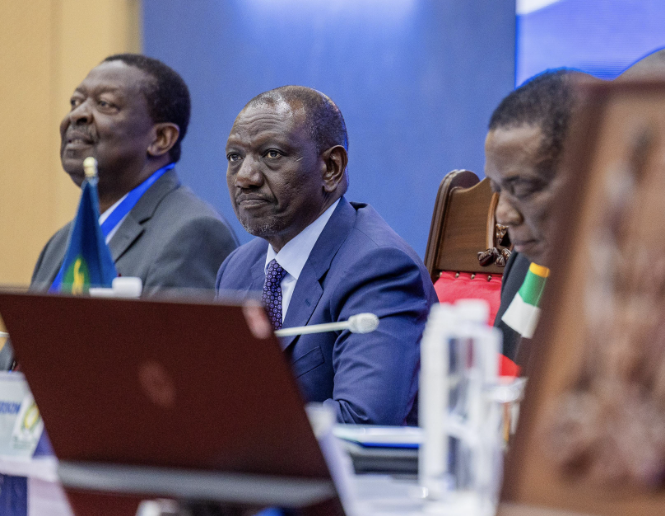
Prime Cabinet Minister Musalia Mudavadi, President William Ruto and his Zimbabwean counterpart Emmerson Mnangagwa at the joint summit of East African Community and Southern African Development Community heads of state in Dar es Salaam, Tanzania /EDWARD ALUSA /PCS
The EAC-SADC Summit on the DRC crisis has directed the merger of the Luanda and Nairobi peace processes, and the resumption of direct negotiations and dialogue between Kinshasa and M23 and other non-state actors within the merged process.
The regional leaders noted at the weekend that the two processes were critical, resolving to strengthen them individually to “enhance complementarity”.
Following the summit’s consideration of the EAC and SADC ministerial meeting held on Friday, the regional leaders said political and diplomatic engagement was the most suitable solution to the DRC conflict.
In his opening remarks, President William Ruto, who is the EAC chairman, said there is no military solution to the DRC conflict.
“We must resist the temptation to think we can somehow shoot and bombard our way into a solution to such a complex situation. Instead, we have to agree that only a comprehensive, diplomatic approach, one that addresses the root causes of the crisis, secures the historical integrity and territorial integrity of DRC and affirms the sovereignty of his people and their aspirations for freedom, justice and development,” he said.
Ruto had also proposed that the regional blocs work on a “fused, single and coherent initiative” towards the resolution of the complex DRC crisis.
“Such an approach will bring together all our assets and minimise the possibility of parallel initiatives that duplicate and undermine progress, including creating unnecessary competition as we strive for peace,” he said.
At the 24th Extraordinary EAC Summit on the DRC, Rwanda President Paul Kagame regretted that the Nairobi and Luanda processes had become an end in themselves, and their facilitators became more important than the results of the processes.
“The Nairobi Process became an Uhuru Process, the Luanda Process is like you cannot say anything that will displease President Lourenço,” Kagame, who walked out of the Luanda process last year, said.
In consultation with the African Union, the summit mandated the co-chairs of the two processes — former President Uhuru Kenyatta for the Nairobi process and Angola President JoãoLourenço for the Luanda process — to consider and appoint additional facilitators, including from other African regions to support the merged processes.
In his report to the joint summit, Uhuru, who is the EAC peace facilitator, had called for the resumption of the Nairobi process, which he regretted had been sidelined.
“The Nairobi Process, though “temporarily sidelined”, and the Luanda process are still critical frameworks for dialogue and conflict resolution in the eastern DRC,” Uhuru said.
He said he remained committed to finding pathways to peace, in collaboration with the government of the DRC, regional partners, and international stakeholders.










